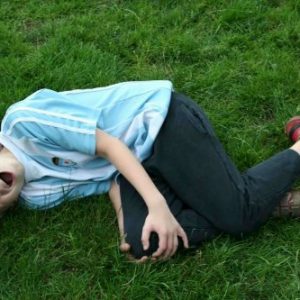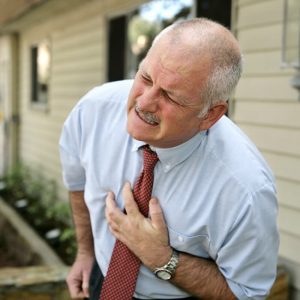In the General structure of domestic injuries burns boiling water is one of the leading places. Thermal damage of the skin and mucous membranes caused by the contact of the fabric with very hot water or steam.
Most burns are boiling water are characterized by a favorable course and do not lead to serious consequences, causing only temporary disability.
However, serious soft tissue injury requiring prolonged treatment in the hospital (burn center).
What determines the severity of the lesion?
There are a number of factors that determine the severity of a burn with boiling water.
These include:
- water temperature;
- the time of direct contact with the skin;
- the pressure of the fluid or vapor;
- the structural features of the affected area of the body;
- the composition of the liquid.
The higher the temperature of the liquid, the greater thermal trauma. A clear direct relationship also exists between the exposure time and severity of the burn. Adverse effects have pure hot water significantly less than brine or syrup.
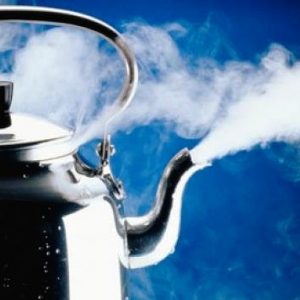
The most affects the hands and forearms. Frequent damage to feet, legs, hips and abdomen. Somewhat less common are burns of the chest.
The share of superficial burns with boiling water accounts for up to 85% of cases. Fortunately, in most cases, the area of the lesion is relatively small. The prognosis for such thermal injuries in adults, as a rule, quite favorable. The hardest part of the recovery process occurs in young children. Due to the small total area of the skin, the magnitude of the defeat they have often quite large.
Classification and symptoms
To assess the severity of burns with boiling water, as well as other thermal injury, are divided into degrees (one through four). Timely professional evaluation enables us to provide the most appropriate first aid, and to reduce the negative consequences.
All burns are characterized by development of pain syndrome of high intensity.
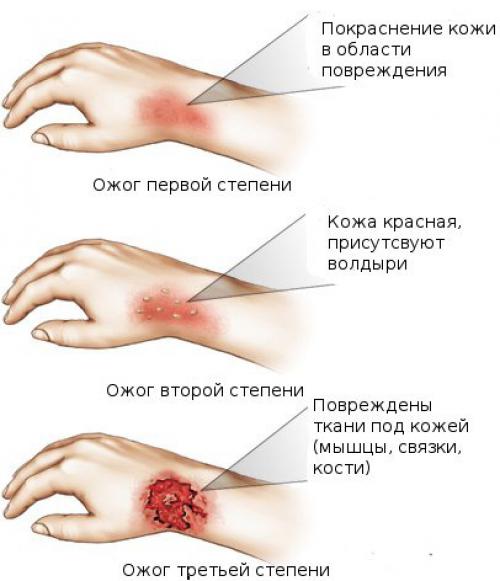
At 1 degree lesion affects only the upper (epidermal) layer. There is hyperemia of the skin and a little swelling, which disappear in a few days or even hours.
For 2 degree characterized by damage to deeper layers of the skin (dermis). Clinical signs of injury are not only redness and swelling, but the formation of bubbles with clear content. The individual vesicles tend to merge. In the absence of infectious complications recovery from second-degree burn usually takes from a half to two weeks (usually within 12 days).
In 3rd degree thermal lesion affects not only the skin, but more deeply located soft tissue. For degree 3A is characterized by the appearance of bubbles with sukrovichnye contents after opening, which is formed wound surface with moderate bleeding, and later formed scabs. Recovery occurs at the expense of surviving undamaged skin cells, hair follicles, sweat and sebaceous glands. Degree 3 is characterized by tissue necrosis. Healing occurs with formation of scar tissue.
The most severe degree of 4, which results in deep soft tissue necrosis (bones), burns with boiling water is extremely rare.
To determine the area of the burn using the so-called “rule of nines” or the method of Wallace. According to him, the whole surface of the human body can be divided into areas that are multiples of 9.
The crotch is only 1%, but the burns of this region the most painful and dangerous in terms of complications.
The arm is 9%, head 9%, anterior torso (chest and abdomen) is 18%, back – 18% each leg – 18%.
To seek qualified help is necessary, if struck by more than 15% of the area of the skin.
The area can roughly be measured palm is 1%. In any case it is impossible to put a hand to the burnt skin!
Burns the body of 3 degrees is dangerous because there is a likelihood of damage to internal organs. The most serious of localization are considered to be thermal injuries to the head (especially the facial area) because they can further hurt the eyes and upper respiratory system.
What not to do with burns?
If items of clothing are not separated from the areas burn even after a heavy wetting, you should not try to remove them; better to do doctors in sterile conditions.
To tear or puncture the blisters formed in any case is impossible, to avoid infection. This should be done only by a doctor after appropriate treatment in a medical establishment.
Avoid self treatment of the affected areas with potassium permanganate or alcoholic rastorm (including iodine). The standard aggressive antiseptics adds to thermal and chemical burn more, which greatly complicate the process of regeneration. In addition, they paint the skin, making it difficult to diagnose.
Can not be applied to broken skin means at hand, composed of fats. Sour cream, butter, creams, etc. create on the skin’s surface impermeable to air film which prevents the natural cooling.
If there are doubts in expediency of bandaging it or you don’t know how to do it correctly, you do not need to conduct this procedure. Too tight bandaging will cause additional swelling.
The treatment of burns
If the child suffered, in any case, you should immediately call the team “ambulance”. The skin and cellular spaces layer in children is relatively thin, so visually determine how bad really is the damage is not always possible.
First aid for burns with boiling water
The first thing to interrupt the influence of thermal factor and cooling affected area. It must be placed under running water (or in napoenny pelvis) not less than 20-25 minutes.

This measure allows to reduce the intensity of pain and reduce skin damage. Excessively cold water should not be used, because hypothermia is an additional traumatic factor. You can use an ice pack, but be sure to wrap a cloth. In the vast area of the burn victim it is advisable to wrap wet sheetswhich, after drying, will need dopolnitelno to moisten. Hypothermia is a mandatory element of first aid, as primary affected tissue keep elevated temperature, compounding the pathological process.
If the burnt area is covered with clothing, it must as soon as possible to remove (if painless to remove does not work, you need to cut). You also need to remove jewelry – bracelets, earrings and rings.
After the surface is washed and cooled, it needs to be closed with a sterile bandage (dry or wet-to-dry) to prevent infection. It is advisable to moisten a bandage with antiseptic water-based – dioxidine or furatsilina. You can add the available anesthetics solution of novocaine or lidocaine.
The burns of 1-2 degrees is useful to put Olasal, Panthoderm, Bepanthen or Panthenol ointment, but you need the time to do it before the formation of the bubbles.
The pharmacy can buy sterile wipes impregnated with anesthetic or cream La foi, which is the active ingredients panthenol and plant extracts (extracts of walnut, succession and licorice).
Received a thermal injury, a person need to drink, especially when it comes to extensive burns. To reduce the pain of the victim is recommended to give the tablet of analgesic (e.g. up Pentalgin) or NSAIDs (Ketorol, Ketoprofen, Paracetamol etc.).
The boiling water burns first degree usually do not require further intervention. Medical care in the second is required only in case of secondary bacterial complications. Treatment of injuries 3 and 4 degrees is carried out only in a hospital.
Medical manipulation
For burns 2 and 3A degree in a medical institution is carried out anesthesia and antiseptic treatment. Flaking areas of the epidermis, possible contamination and fragments of clothes gently removed. Blisters the doctor pierces with a sterile needle or incision laterally and remove sukrovichnye exudate (thin skin be sure to leave it for a speedy healing). The affected area covered with sterile bandage with antibacterial ointment; its replacement is carried out every 2-3 days in the clinic or hospital.
Burns 3B and 4 degrees, and the defeat of more than 30% of the skin are the absolute indications for hospitalization to the nearest burn center. Specialists combustiological carried out in the first removal of necrotic tissue. According to the testimony surgical procedures are conducted under General anesthesia. When pain shock carried out a complex of measures aimed at maintaining vital body functions.
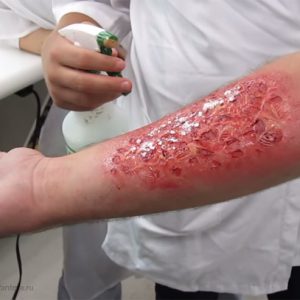
As soon as the dead skin is rejected, on the site of the lesion begins to form a scab. At this stage, the main task of doctors becomes the prevention of secondary bacterial complications.
The treatment of severe burns can be open or closed method. The open method involves applying bandages, and outdoor – only lubrication antiseptic. The choice of tactics depends on the depth and location of lesion. On the damaged area 3-4 times daily applied antiseptic preparations in the form of ointments.
Even the burns of 2 degrees can pose a threat to life, if their area exceeds 30% of the surface of the skin. Lesions of grade 3 and 4 are very dangerous, even if the affected is not more than 10% of the area of the body.
The patient is transferred to outpatient treatment only after the danger of burn disease and infection, and began the process of regeneration.
Recipes of traditional medicine
Remember, to use traditional remedies only in mild burns in the absence of complications. Before you use a particular tool, it is recommended to consult with your doctor.
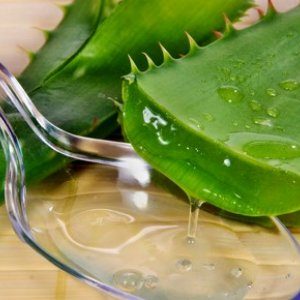
Recipe 1
Finely chop some fresh aloe leaf and squeeze the juice from them. Moisten it with a sterile bandage, and apply to the burn. Instead of lotions at the small area affected, you can use just cut along the leaf this medicinal plant.
Recipe 2
Grate on a fine grater raw potatoes (you will need 100 g) and add to it a teaspoon of natural honey. Thoroughly mix all ingredients, wrap them in sterile gauze and apply the compress for 2 hours to the affected area of the skin. It is recommended to repeat the procedure 2-3 times during the day. Contraindication is allergic to honey and other bee products.
Recipe 3
For burns with boiling water a good helping of gadgets with a strong infusion of tea. Suitable for both green and ordinary black tea. Gauze soaked in welding must be applied to the sore to 3-4 times a day, leaving to dry completely.
Tissue repair and wound healing without formation of scar tissue promotes sea buckthorn oil, but, like other funds with vegetable fats, it should not be applied immediately after the initial injury.
If superficial burns pain and inflammation do not improve within 2 weeks or more, it is with high probability says about the infection. With long-term preservation (or progression) of clinical symptoms, should as soon as possible to get on reception to the doctor.

